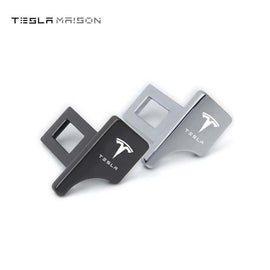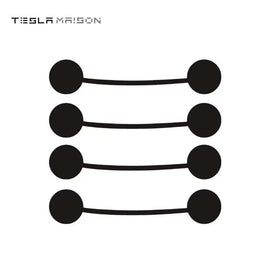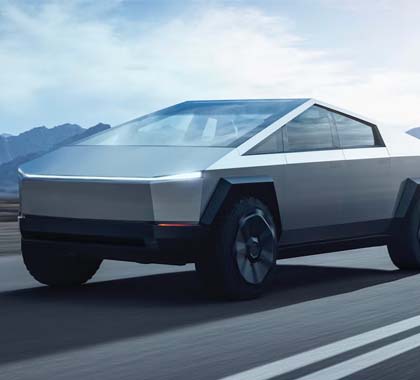Anyone would not want to run out fuel while driving. This can mean a long walk to the nearest station or calling your friend to come and bring you gas. You know what you should do, in most cases.
The Tesla battery can die on the road. If it does, the only thing you can do is call a flatbed vehicle to tow you back to a charging station. All Teslas are covered by roadside service for the first four or fifty thousand miles. There is a small fee for the "Out Of Charge" towing services, but you will be towed directly to the closest charger.
Tesla owners may find themselves in a brand-new situation. You can't simply walk into a gas station to fill a can. You can't just call a friend and ask them to bring you some electricity. We'll talk about how you can avoid this mess in the first instance.
Read More: Tesla Guide: Does Tesla Lose Power When It Is Parked In A Garage?
Tesla Low Battery Signs
Tesla's navigation systems show you where the nearest superchargers or destination chargers on your route are. The system displays the battery charge, as well an estimation of how much mileage you still have before your car is empty.
More warning signs will be activated if you do not notice the meter getting low.
- Tesla will notify you if you have a low battery and are out of the range of superchargers.
- Tesla will suggest that you slow down if your battery is running low and you're nearing your destination. It will keep recommending a particular speed until you arrive at your destination.
- The battery icon will change from yellow into red when you are at the last 10%.
- Tesla's mobile app will send you a notification if your battery drops below 10% during idling.
- On your main screen, you will see a big notification that says "Charge Now" when your car has reached 5%.
- You can continue driving after this point. The car will begin to slow down, and it will become sluggish. Finally, you'll be given the message to "Pullover Safely."
That is a lot of warning.
If you completely run out of power in your Tesla, the 12V battery will still allow you to open the hatch to charge the car and put it into towing mode.
Read More: Tesla Guide: What Is Tesla Valet Mode? And How To Use It?

How to Tow a Tesla
The first step is to contact Tesla Roadside Assistance. A vehicle transporter will be sent to move your vehicle.
Tesla Roadside Assistance is available at 877-798-352. You can also contact them through your Tesla Smartphone App.
Tesla Roadside Assistance is free for Flat Tires, Breakdown Towing, and Lockouts. Out of Range Towing, however, has a small cost.
Towing with a Tesla differs from towing with a regular car. What you need to know is:
- Flatbed: Teslas can only be towed by a Flat Bed truck.
- Disable “Self-Leveling”: You will need to activate the “Jack Mode” if you own a Model S that has air suspension to stop it from self-leveling while transporting. Without this feature, the vehicle can become loose on the flatbed.
- Select "Tow Mode": To disable the automatic emergency braking when leaving the vehicle and to keep it in neutral you need to select "Tow Mode". Place your vehicle in Neutral, but don't get out. This will trigger the Auto-Parking feature and emergency brake.
Read More: Tesla Guide: Is It A Good Idea To Buy A Used Tesla?
How far can I drive my Tesla?
Like traditional gas cars, the range of Teslas depends on your driving style and environment. The range is an estimate for how far a Tesla can be driven on a single battery charge.
Most estimates are calculated based on an average speed of about 65 mph. Going faster than this will decrease your range. Tesla also reports these factors that may limit your range.
- Stop-and-go speeds
- Short trips
- You can also climb uphill
- Inclement weather can include rain, snow or strong headwinds
- Low Tire Pressure
- Use of A/C or heat system excessive
Tesla is always improving the range of its vehicles. Tesla’s website provides the most up-to-date information about the maximum range of Tesla vehicles.
Read More: 2023 Tesla Guide: Is The Tesla Model 3 An Ideal Family Car?
Can I increase my Tesla's range?
By following a few tips to save energy, you can increase the maximum range your Tesla gets per charge.
- Keep your speed constant. Driving at a slower speed will increase the driving range.
- Select "Chill". You can extend the range of the Tesla by using less energy. The car will still be among the fastest from a red light but it'll be much slower than the "Sport" setting.
- Tesla uses regenerative breaking, as do most electric cars. When your car coasts or brakes, power is returned to the battery. Tesla's regenerative brakes come in two different settings: Standard or Low. The Standard option may be a bit more difficult to get used to but is much more efficient.
- Instead of using the heater, use seat warmers. The seat warmer feature will keep you warm and use less energy than the air vent heating system.
- Keep your vehicle aerodynamic. Remove any attachments that you don't use, such as a roof or bike rack.
- Don't pack too much. The lighter the vehicle is, the more energy it can use to transport you.
- Attention to driving habits. While these tips may be helpful in an emergency, the key to conserving energy is to understand how you use your vehicle's power while driving. Tesla's energy screen on the touchscreen lets you know how well you've driven.
How much should I charge my Tesla?
Tesla advises to not charge the vehicle beyond 90%, or allow it to drop below 20%. Set your charging limits to lower than 90% to ensure that the vehicle will automatically stop charging when it reaches its limit.
Use high-voltage chargers, such as superchargers, for only short periods and only when necessary. It is better to use a low voltage charger for battery longevity. It is recommended that you charge your battery every night with a 120v or 24v charger.
Read More: Tesla Guide: How To Charge A Tesla While On A Road Trip?

Tesla Charge Port Color Guide
The light around your Tesla charge port is able to communicate with you in a number of ways:
- White - The charge port's door is opened, but there is no connector inserted. The connector could be ready to be removed if the latch has been released.
- Blue - Your car detects a connector plugged in.
- Blinking Blue – Your car is charging or a session of charging will begin at a specific time.
- Blinking green - Fast: Charging has begun. Slower: Your vehicle is nearing full charge.
- Solid Green - Charging has been completed.
- Solid Amber - The connector is not fully connected. Realign the connector and plug it in fully.
- Blinking Amber - Your car is charging on reduced current only (AC charging).
- Red - A red indicates that a fault has been detected and the charging process has stopped. Check for error messages.
Want to see a colorful Tesla surprise in your future? In some Tesla models, pressing the charge button 10 times quickly on the handle of the charger will cause the color to flash.
Find Superchargers Near You
When driving your Tesla, you can see the closest superchargers on your navigation display.
If you're outside of your Tesla and need to do some research on supercharger locations, you can use the Tesla mobile app or navigate to tesla.com/superchargers.
You can plan out your route and the charging stops using .
Read More: Tesla Guide: Does Tesla Lose Power When It Is Parked In A Garage?
Supercharger vs. Destination Chargers
Tesla has two charging stations that are specifically designed for Tesla drivers. These are the Superchargers (for Teslas) and Destination Chargers.
Superchargersare designed to be quick charging stations and are part of DC fast-charging networks. These chargers are Level 3, which means they can charge at speeds between 300 and 1000 miles per hour. The number of superchargers is limited outside of large metropolitan areas. Therefore, planning ahead for long trips before you leave home is important.
Tesla Superchargers are based on kilowatt hours (kWh). Superchargers charge by the kilowatt-hour (kWh).
Chargers for Destinationsare intended to charge faster and are located in parking garages, hotels, shopping centres, or other public places. They are Level 2 chargers and can charge up to 40 miles per hour.
Many destination chargers, particularly at hotels where you are a customer, are free. Some destination chargers may charge a fee or require that you pay parking to use them.
Where can I charge my Tesla elsewhere?
The Tesla can technically be recharged using any outlet. However, a residential outlet takes a very long time. Standard wall sockets are Level 1 chargers. They can charge up to 3-5 miles an hour. Overnight charging is common at home.
Bring the charger cable with you whenever you travel. So you can charge your Tesla for free at any outlet. Tesla also sells a outlet adapter that can be used to plug into 240v sockets for free faster charging.
You'll want to make sure you have a 240v charger with you if you plan on camping overnight in a campground that has an electric plug. You can charge your device overnight for free by plugging it in.
Remember to charge your phone and use the adaptor!
How long does it usually take to charge an electric vehicle?
The charging time for an electric vehicle can be anywhere from 30 minutes to multiple day depending on the size of battery and the charging speed.
| Model | Battery | Range Between Charges | Level 1 Charging | Level 2 Charging | Level 3 Charging |
| Tesla Model S | 100kWh | 348-396 miles | 87-99 hours | 6-30 hours | 30 minutes* |
| Tesla Model 3 | 82kWh | 267-358 miles | 67-90 hours | 8-11 hours | 40-60 minutes* |
| Nissan Leaf | 40kWh | 168 miles | 20 hours | 4-8 hours | 30 minutes |
| Smart EQ forfour | 18kWh | 99 miles | 11.5 hours | 5 hours | Not available for this vehicle |
| Chevy Volt | 18kWh | 53 miles | 14 hours | 9.5 hours | 1 hour 20 minutes |
| Mitsubishi Outlander PHEV | 14kWh | 28 miles | 5 hours | 3.5 hours | 80 percent in 25 minutes |
Teslas charge their vehicles in as little as 30-40 mins. Their fast chargers, called Tesla Superchargers, are a bit different. Supercharger maps are built-in to the Tesla navigation system. To keep your Tesla charged, level 1 charging should be used for overnight and daily charging. A standard Level 1 charger in your home will easily make up the distance if you commute 50 miles each day.
What are the various types of charging available for an electric vehicle?
There are three types of charging for electric vehicles: Level 1, level 2, and level 3 DC fast charging. According to Union of Concerned Scientists:
- Level 1 charging: Can be used at home with a standard 120-volt wall socket. This level is ideal if your vehicle will be parked at home for several hours.
- Level 2 charging: Level 1 charging works about six times as fast as level 2 charging. Level 2 charging is available at most public stations, and can be installed at home. This level of charging will work best when the vehicle is parked for an hour or more.
- Level 3 DC Fast Charging stations are capable of delivering 80% or more power to some electric cars in as little as 20-30 min. This charging option does not apply to all-electric vehicles; plug-in-hybrids can usually only be charged at level 1 or 2
What are the Top Electric Vehicle Charging networks?
Third-party chargers are becoming more common. They include Tesla Superchargers, Destination Chargers and many others. The following is a listing of electric vehicle charger networks:
- Tesla Destination Chargers, and Tesla Superchargers only apply to Tesla Owners and require no additional membership. Tesla owners just pull up and plug into any of the thousands Superchargers, or Destination Charging Stations. Costs are determined by kWh. Typically, they range between $0.25 and $0.50 per kWh. However, this varies from state to state.
- Blink Network can be found in all 50 states. Blink charges no membership fee, but charging stations can range from $0.40 up to $.80 a kWh, depending on your state.
- ChargePoint is a charging network that has more than 100,000 chargers across the country. It is therefore highly recommended to all-electric vehicle owners to create an account. ChargePoint's are generally free of charge, though some owners may choose to pay for their charges.
- eVgo service is located primarily in Texas, but also has branches in Tennessee, California, and Washington, D.C., as well. Their company says that a membership is required but "they'll always help EV drivers in need of a charging."
- SemaConnectis Maryland-based company with more than 1,000 charging stations. The property owner determines the cost, but a membership is required.
- The Electric Circuit, the largest public charging system in Quebec with over 3,400 stations across Canada. A level 2 charger costs $2.50 regardless of how long it is used.
Do you need a back-up gas powered car?
How well-planned you are and how much you value your life, will determine whether you can give up the gas car and switch to a Tesla or another electric vehicle.
Do you tend to forget to plug in your car at nights and have to be on time to work? It's likely that you would benefit from a backup.
Or maybe you're worried about making it over long distances. Electric vehicle drivers are less concerned about this issue as charging stations for their vehicles become more common.
It may be cheaper to hire a car if you are going on a long distance trip far away from the electric vehicle charging stations. This will save you money in maintenance costs and you won't have to worry about another vehicle that you only use occasionally for long trips.
Hopefully, this article helped you understand Teslas better and how to handle a dead battery on the go.
Read More: Tesla Guide: What You Need To Know About Charging Your Tesla?































